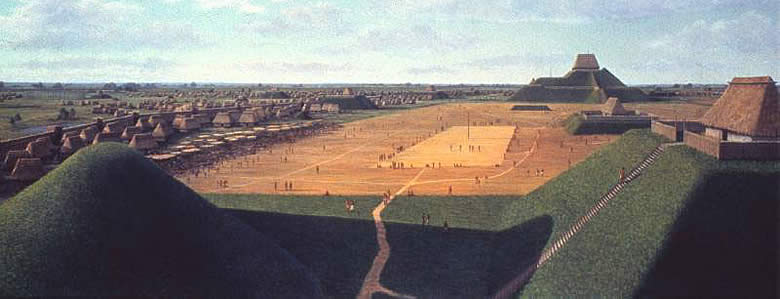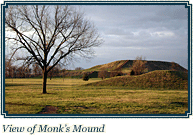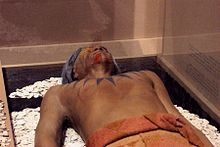Not-quite-the-world-traveler: Cahokia Mounds, IL

The rush of noise from busy metropolitan St. Louis, the shine of sunlight on the famous arch, the hustle and bustle of 21st century life fade away in the silence of the muggy air on a grassy hilltop in Illinois. Hundreds of thousands of people live just a stone's throw away in St. Louis, many unaware how great an impact a few quiet grassy mounds set with the modern convenience of stairs and handrails truly had on the people of this area, albeit before any of their lifetimes.
Today on the top of the largest of the mounds mounds, it is quiet and still, the nearby Mississippi river glinting as it wends its way to the gulf, the only sound the gentle breeze over the grassy hilltop rustling the blades against one another and a lazy insect settling onto the grass heads. A few scattered people wander about, some stopping to read the plaques, but most seemingly unaware and somehow not fully impacted by the ancient majesty that was Cahokia. To understand that standing in this place is to stand in the nexus of the ancient cradle of civilization, the largest city of its time on the North American continent or in Europe, the locus of intersecting continent-spanning trade routes seems to pass most of these people by as quickly as cars on the nearby highway. But I am awestruck.
 View of St. Louis from Monk's Mound
View of St. Louis from Monk's MoundLet's go back, to a time when Europe's biggest cities housed only tens of thousands, instead of tens of millions. Back to a time before modern conveniences, before global travel, before the technological age descended upon this mound of grass and to the history that is Cahokia.
It's AD 1250 and Cahokia is one of the greatest ancient cities of the world. At this time, it was larger, in fact, than London. An estimated 15,000 to 20,000 citizens in the city proper and up to 30,000 to 40,000 surrounding inhabitants congregated here in a settlement ranging from everyday dwellings to ceremonial structures, occupying a variety of different sized mounds and even giant red cedar woodhenges serving as solar calendars.
A reconstruction demonstrates Cahokia's astronomical sophistication, which was comparable to that of other ancient civilizations. Cahokia remains the largest archaeological site north of Mexico and contains artifacts from well outside the geographic area, indicating an extensive trade network including elaborate pottery, precious metals such as copper from the Great Lakes region, chert for making tools and implements and minerals like galena. (Per Wikipedia, one of the oldest uses of galena was as kohl, which, in Ancient Egypt, was applied around the eyes to reduce the glare of the desert sun and to repel flies, which were a potential source of disease).
Also found in the excavation of Cahokia were exotic shark's teeth and fighting whelk shells brought in from locations far removed from present-day Illinois. How did these artifacts arrive here? What is the story that they tell, and most importantly... where did all the people go?
 Artist's reconstruction of Cahokia, the largest and most powerful of all Mississippian centers, at about A.D. 1150. The paramount chief, perhaps called the Great Sun, lived atop Monk's Mound, the large mound shown in the background. Painting by L. K. Townsend, courtesy Cahokia Mounds State Historic Site.
Artist's reconstruction of Cahokia, the largest and most powerful of all Mississippian centers, at about A.D. 1150. The paramount chief, perhaps called the Great Sun, lived atop Monk's Mound, the large mound shown in the background. Painting by L. K. Townsend, courtesy Cahokia Mounds State Historic Site.
A reconstruction demonstrates Cahokia's astronomical sophistication, which was comparable to that of other ancient civilizations. Cahokia remains the largest archaeological site north of Mexico and contains artifacts from well outside the geographic area, indicating an extensive trade network including elaborate pottery, precious metals such as copper from the Great Lakes region, chert for making tools and implements and minerals like galena. (Per Wikipedia, one of the oldest uses of galena was as kohl, which, in Ancient Egypt, was applied around the eyes to reduce the glare of the desert sun and to repel flies, which were a potential source of disease).
Also found in the excavation of Cahokia were exotic shark's teeth and fighting whelk shells brought in from locations far removed from present-day Illinois. How did these artifacts arrive here? What is the story that they tell, and most importantly... where did all the people go?
 Artist's reconstruction of Cahokia, the largest and most powerful of all Mississippian centers, at about A.D. 1150. The paramount chief, perhaps called the Great Sun, lived atop Monk's Mound, the large mound shown in the background. Painting by L. K. Townsend, courtesy Cahokia Mounds State Historic Site.
Artist's reconstruction of Cahokia, the largest and most powerful of all Mississippian centers, at about A.D. 1150. The paramount chief, perhaps called the Great Sun, lived atop Monk's Mound, the large mound shown in the background. Painting by L. K. Townsend, courtesy Cahokia Mounds State Historic Site. Copper repoussé plaques, A.D. 1200-1400 - Unearthed by a farmer plowing a field, a plaque depicting a birdman figure is made of copper from the Great Lakes region, evidence that Cahokia and other communities were part of a far-reaching trade network.
Copper repoussé plaques, A.D. 1200-1400 - Unearthed by a farmer plowing a field, a plaque depicting a birdman figure is made of copper from the Great Lakes region, evidence that Cahokia and other communities were part of a far-reaching trade network.
Cahokia Mounds excavations have revealed a diverse and interesting mosaic of occupation. A great civilization of advanced peoples thrived at Cahokia long before European settlers came to North America.
A basic timeline begins our story a thousand years ago where a small society flourished in the fertile floodplain of the Mississippi River.
Beginning in 700 AD, Late Woodland people left projectile points to mark their time spent in the area, but had no established long-lasting presence in what would eventually become Cahokia.
By 800 AD with the cultivation of maize, Mississippian culture advanced along with the emerging agriculturally-based lifestyle. This crop planting and harvest cycle led people to settle in larger, more stationary communities to tend their crops.
Around 900 AD, pithouses had sprung up for the labor to produce the crop that had become a staple of this culture's diet. Corn had become essential, and required workers to tend it.
Suddenly, in 1050 AD, a dramatic population increase coincides with advancing forms of leadership and a complicated hierarchical structure, all of which were drawing outlying communities to a central location. Over 17 different styles of projectile points were found dating from this time period, ranging in both style and structure, and new housing styles appear as well, possibly indicating the integration of other tribal groups.
From 1100-1200 AD, in what is referred to as the "Golden Age" of Cahokia, the largest numbers of peoples, rivaling and even surpassing the largest of European cities at the time, had established roots in Cahokia. Creating five giant woodhenges to mark the passage of the seasons, the celestial events of solstices and equinoxes and serving, in essence, as giant calendars, Cahokia truly becomes a cultural phenomenon.
The largest of the mounds is constructed around 1150 AD, and would have been swarmed with thousands of workers during construction, which required an estimated 22 million cubic feet of earth, 15 million baskets of soil. "Monk's Mound" (so named for acommunity of monks that resided near there for a short time after Euroamericans settled) covers 14 acres, rises 100 ft from its base, and was the foundation to a massive 5,000 sq ft building that rose an additional 50 ft high. To give perspective, this mound has a footprint more than twice that of the Roman Colosseum, and it is larger at its base than the Great Pyramid of Khufu, Egypt's largest.


To our jaded modern eye, that may pale in comparison with St. Louis' glittering skyscrapers sheathed in glass, but the world's first steel frame skyscraper was the Home Insurance Building (originally 10 stories with a height of 138 ft) in Chicago, Illinois in 1885, long after the construction of Cahokia's great mound reached skyward. Monk's Mound is the only multi-terraced mound in eastern North America, and is the largest man-made earthen mound on the entire North American continent.
Adjacent to the great mound was a great plaza covering nearly 50 acres (the size of 45 football fields) where the games were played and public rituals carried out. The most common of the games was "Chunkey", wherein a pill-shaped stone was rolled across the field and men would throw their spears where they predicted the stone would land, requiring great judgement and even better aim. Particularly as the rumored price for defeat was the forfeit of one's life and head.
Adjacent to the great mound was a great plaza covering nearly 50 acres (the size of 45 football fields) where the games were played and public rituals carried out. The most common of the games was "Chunkey", wherein a pill-shaped stone was rolled across the field and men would throw their spears where they predicted the stone would land, requiring great judgement and even better aim. Particularly as the rumored price for defeat was the forfeit of one's life and head.
 Illustration of a chunkey player based on a Mississippian gorget design. Artist Herb Roe
Illustration of a chunkey player based on a Mississippian gorget design. Artist Herb Roe Chunkey player flint clay figurine effigy pipe from Cahokia
Chunkey player flint clay figurine effigy pipe from CahokiaFrom atop this mound, the residing officials would have seen the grandeur of this city at the height of its population. The sight would have been monumental, the mound being the highest structure in the entire floodplain, and located near the confluence of the Mississippi, Missouri and Illinois rivers and maintaining trade links from the Great Lakes to the north and the Gulf coast to the south. At its apex, Cahokia covered approximately 6 square miles and included around 120 man-man earthen mounds in a variety of shapes, sizes and functions and its ancient population would not be surpassed by any city in the United States until around 1800. Never again would Cahokia see this level of population and expansion. Never again would it be at the peak of civilization, industry, trade and the religious, cultural and ceremonial center of this society. Cahokia was a ghost town before Columbus even landed.
The Mississippian peoples experienced a marked decline, and had entirely departed by the 1300s, and in the 1400s only a few sparse Oneota villages to the north had been settled. In the 1600s, Illiniwek confederacy and the sub-tribe of Cahokia moved into the area and actually occupied Monk's Mound for a short time around 20 years. When the French came through in the 1700s the Cahokia peoples were inhabiting nearby and it is for them that the mounds are named, or rather mis-named, as they did not build them, but merely came upon them later.
Today, aside from the artifacts left buried, only the mystery remains - where did they all go?
The fate of these ancient people is unknown. Even to what they called themselves and the borrowed name assigned to their city by people who never actually lived there. Was it catastrophic disease, crop failure due to the proven climate climate change, threat of warfare and subsequent assimilation into other tribes, declining socio-economic power and simple abandonment of the site, pollution, waste buildup, deforestation, erosion, and over-hunting contributing to the depletion of resources? These and many more causes have all been theorized, but no one knows a definitive answer. Alone, the mystery and the mounds remain, swirling in my mind as I stand, alone, atop Monk's Mound.
------------------------------- More info from the Web:-----------------------------------------

According to the Cahokia Mounds website: Common characteristics exhibited by the Mississippian culture included:
- Large communal plazas.
- Monumental 'public' architecture.
- Flat-topped Temple Mounds, sometimes paired with round top burial mounds.
- A particular set of religious symbols, found on pottery, copper, shell and stone.
- Complex hierarchical society.
- The occasional practice of human sacrifice.
- Specific styles and decorations on (usually shell-tempered) pottery.
- The practice of playing the game called "chunkey" with a stone disc rolled down a prepared court.
- Palisaded villages.
- Houses with wall post set in narrow trenches.
During excavation of Mound 72, a ridge-top burial mound south of Monks Mound, archaeologists found the remains of a man in his 40s who was probably an important Cahokian ruler. The man was buried on a bed of more than 20,000 marine-shell disc beads arranged in the shape of a falcon, with the bird's head appearing beneath and beside the man's head, and its wings and tail beneath his arms and legs. The falcon warrior or "birdman" is a common motif in Mississippian culture. This burial clearly had powerfuliconographic significance. In addition, a cache of sophisticated, finely worked arrowheads in a variety of different styles and materials was found near the grave of this important man. Separated into four types, each from a different geographical region, the arrowheads demonstrated Cahokia's extensive trade links in North America.
 Reconstruction of the Birdman burial in the site's interpretative center
Reconstruction of the Birdman burial in the site's interpretative center- Four young males, missing their hands and skulls.
- A mass grave of more than 50 women around 21 years old, with the bodies arranged in two layers separated by matting.
- A mass burial containing 40 men and women who appear to have been violently killed. The suggestion has been made that some of these were buried alive: "From the vertical position of some of the fingers, which appear to have been digging in the sand, it is apparent that not all of the victims were dead when they were interred – that some had been trying to pull themselves out of the mass of bodies."
The Birdman Tablet, the official logo of Cahokia Mounds, was found during excavations on the east side of Monks Mound in 1971. The image on the 'front' of the tablet is of a human, dressed in eagle (or falcon) regalia. The 'reverse' of the tablet is plain or cross-hatched, suggesting the pattern on the skin of a snake.
The Birdman Tablet, the official logo of Cahokia Mounds, was found during excavations on the east side of Monks Mound in 1971. The image on the 'front' of the tablet is of a human, dressed in eagle (or falcon) regalia. The 'reverse' of the tablet is plain or cross-hatched, suggesting the pattern on the skin of a snake.

In 1982, the United Nations Educational, Scientific, and Cultural Organization (UNESCO), designated Cahokia Mounds a World Heritage Site for its importance to our understanding of the prehistory of North America. Cahokia Mounds State Historic Site is one of only 21 World Heritage Sites in the United States, and has also been recognized as a U. S. National Historic Landmark. It covers 2,200 acres and is located directly across the Mississippi River from modern St. Louis, Missouri and houses an Interpretive Center whichfocuses on its uniqueness as an urban center.

Archeologists recovered more than 250 other skeletons from Mound 72. Scholars believe almost 62 percent of these were sacrificial victims, based on signs of ritual execution, method of burial, and other factors.
The skeletons include:
The relationship of these burials to the central burial is unclear. It is unlikely that they were all deposited at the same time. Wood in several parts of the mound has been radiocarbon-dated to between 950 and 1000 CE.
Excavations have indicated that Mound 72 was not constructed as a single mound, but rather as a series of smaller mounds. These mounds were reshaped and covered over to give Mound 72 its final ridge-top shape.

Excavations begun in 1966 eventually confirmed that an enormous, two-mile-long stockade surrounded the central portion of Cahokia. The wall appears to have been started around A.D. 1100 and then rebuilt three times over a period of 200 years. Each construction required 15,000-20,000 oak and hickory logs, one foot in diameter and twenty feet tall. The logs were sunk into a trench four to five feet deep and were likely supported with horizontal poles or interwoven with saplings. The stockade walls may have been covered with clay, as well, to protect them from fire and moisture.
Because there is no evidence of invasion at Cahokia some people question the purpose of the Stockade. To a degree, it probably served as a social barrier; however, three things lead most archaeologists to believe that it was primarily a defensive structure: the great height of the wall; the presence of evenly spaced bastions, projections from which archers could shoot arrows; and evidence that portions of the wall were hurriedly built, cutting through residential areas, as if danger was imminent.

All photos and web text courtesy Cahokia Mounds official site at www.cahokiamounds.org
National Geographic http://ngm.nationalgeographic.com/2011/01/cahokia/burmeister-photography and http://ngm.nationalgeographic.com/2011/01/cahokia/hodges-text
http://www.texasbeyondhistory.net/tejas/fundamentals/miss.html
and from Wikipedia.
No comments:
Post a Comment